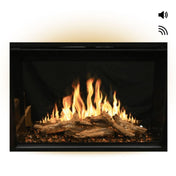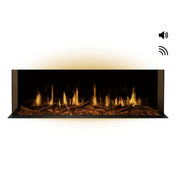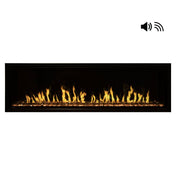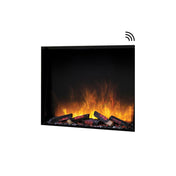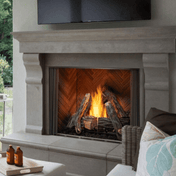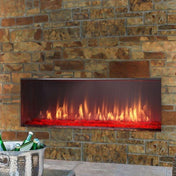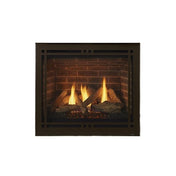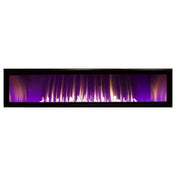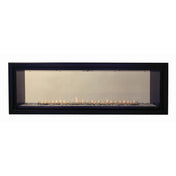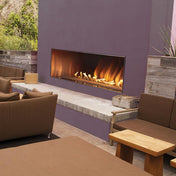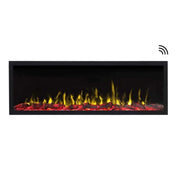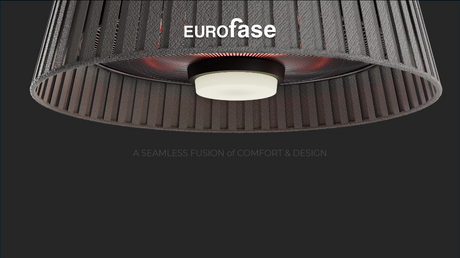Ventless gas fireplaces are a great alternative to conventional wood-burning fireplaces. They don't require an external vent, so they are easier to install and are more energy-efficient than wood or vented gas fireplaces.
Ventless Gas Fireplace Buying Guide Contents
- What Are Ventless Gas Fireplaces?
- How Do Ventless Gas Fireplaces Work?
- Where Are Ventless Gas Fireplaces Banned?
- How to Install a Ventless Gas Fireplace?
- What Types of Ventless Gas Fireplaces Are Available?
- Are Ventless Gas Fireplaces Safe?
- Ventless Gas Fireplaces vs. Other Types of Fireplaces
- Pros and Cons of Ventless Gas Fireplaces
- Can Ventless Gas Fireplaces Be Installed Outdoors?
- How to Choose the Right Ventless Gas Fireplace
What Are Ventless Gas Fireplaces?
Ventless gas fireplaces are powered by either natural gas or liquid propane.
Because they don't require a flue or chimney, they're perfect for newer homes and condos.
They're also much less expensive and easier to install than traditional fireplaces.
Today, most people don't use their fireplace as a primary source of heat. However, if you do want that extra heat, ventless gas fireplaces can heat-up a small house and provide that warm, cozy feel we all know and love.
A wide variety of ventless gas fireplaces are available today. Some are large and serve as a room's focal point, while others are more streamlined and compact. From traditional to modern, there is a ventless gas fireplace for every style.
Click here to read about other types of fireplaces designed for homes without chimneys.

Photo: Empire Boulevard - Linear Vent-Free Gas Fireplace, Sizes: 36" and 48" Long
How Do Ventless Gas Fireplaces Work?
Ventless gas fireplaces work by burning natural gas or liquid propane. The fireplace needs to be properly connected to a gas line and electricity for ignition.
Ignition
Most ventless gas fireplaces can be ignited via a switch, or a push of button on the fireplace or on the remote control.
Power Outage
Many newer models come equipped with automatic ignition, which eliminates the need for standing pilot saving energy and your money. They can also operate on battery backup mode in the event of a power outage.
Heat
Once ignited, the fireplace creates naturally looking flames and lots of heat. Depending on the size of your home, a single vent free gas fireplace may be enough to warm your entire house.
Flames
With most models, you can control the flames size via a dial or a push of a button on the remote. Reducing the flame size also reduces the heat output.
Where Are Ventless Gas Fireplaces Banned?
Ventless gas fireplaces can be safely installed anywhere accessible by a gas line with a few restrictions:
1. Ventless gas fireplaces are banned in some regions
Ventless gas fireplaces are allowed in the majority of the country. However, some states and municipalities restrict where they can be installed or ban them completely.
For example, as of this writing, ventless gas fireplaces are not allowed in the whole state of California. While in Illinois, only some cities do not allow ventless gas fireplaces to be installed.
Some states restrict where ventless gas fireplaces can be installed, for example, in Washington D.C. ventless gas fireplaces are allowed but not in bedrooms and bathrooms.
Regulations are constantly changing, so make sure to check your local building codes before purchasing a ventless gas fireplace.
2. Ventless gas fireplaces don't work in high altitudes
Ventless gas fireplaces are not recommended to use in altitudes above 4500 ft. So if you have a cabin in the mountains that sits above 4500 ft, ventless gas fireplace is not for you.
4. Bathroom installation restrictions
A ventless gas fireplace having a heat output rating of more than 6,000 BTUs per hour shall not be installed in a bathroom.
5. Bedroom installation restrictions
A ventless gas fireplace fireplace with a heat output rating of more than 10,000 BTUs per hour shall not be installed in a bedroom or a bathroom.
We covered the five main restrictions when it comes to ventless gas fireplaces. Keep those in mind, follow proper installation instructions and you will be happy with your ventless gas fireplace.
How to Install a Ventless Gas Fireplace?
Ventless gas fireplaces can be installed in almost any home with a few restrictions discussed in the section above. Ventless gas fireplaces can be installed indoors and outdoors. There are outdoor rated models for installation on outdoor patios and decks.
Ventless gas fireplaces need to be properly connected to a gas line. A licensed HVAC professional must complete the installation to ensure the heating capacity doesn't exceed manufacturer requirements.
There is also a small electrical wiring that needs to be done for the ignition.
So you might need a carpenter, a plumber, and an electrician for this installation.
The installer(s) will follow installation steps outlined in the product manual that comes with every ventless gas fireplace.
Generally the installation steps look like this.
Installation Steps
1. Determine the location
Determine where to install the fireplace. Ventless gas fireplaces usually can be
mounted on any of these surfaces:
- A flat hard combustible or non-combustible surface.
- A raised platform of combustible or non-combustible material.
If installed directly on carpeting, tile or other combustible material other than wood flooring, it must be installed on a metal or wood panel extending the full width and depth of the fireplace.
2. Unpack The Fireplace
This step is pretty self explanatory. Remove all the packaging. Verify that all the parts are included according to the list provided in the manual. Set the fireplace in a location near it's final installation.
3. Frame the wall opening
The wall will need to be framed out to support the fireplace. Non combustible boards need to be used where required.
4. Run a gas line
Run a gas line to the location of the fireplace.
5. Install the wiring
Access to electricity is needed for the ignition.
These 5 installation steps are the most common. Some ventless gas fireplaces will have extra steps like installation of a remote control or a shut of timer. Please make sure to refer to the product manual for installation instructions.
Shop ventless gas fireplace inserts here.

Photo: Superior 43" Linear Vent-Free Gas Fireplace, Optional See-Through (VRL4543)
What Types of Ventless Gas Fireplaces Are Available?
There are numerous, beautiful ventless gas fireplaces available. Whatever your style, you’ll find one that suits your needs.
Here are the 5 types of ventless gas fireplaces we will discuss:
1. Built-in
2. See-through or 2-Sided
3. Outdoor
4. Inserts
1. Built-In Ventless Gas Fireplaces
Built-in fireplaces are designed to be framed into a wall for a classic fireplace look.
Click here to see our collection of Built-in Ventless Gas Fireplaces

Photo: Empire Boulevard 72" Linear Vent-Free Gas Fireplace
2. See-through or 2-Sided Ventless Gas Fireplaces
These fireplaces rare designed to be installed into a dividing wall between two rooms or even between an indoor room and an outdoor patio.
Click here to see our collection of 2-Sided Ventless Gas Fireplaces

Photo: Empire Boulevard 60" Linear Vent-Free See-Through Gas Fireplace
3. Outdoor Ventless Gas FIreplaces
Outdoor ventless gas fireplaces are designed with durability in mind. They are made out of more durable materials, have bigger more forceful flames that won't get blown by a wind and have other features that make them safe and durable in outdoor settings.
Click here to see our collection of Outdoor Ventless Gas Fireplaces
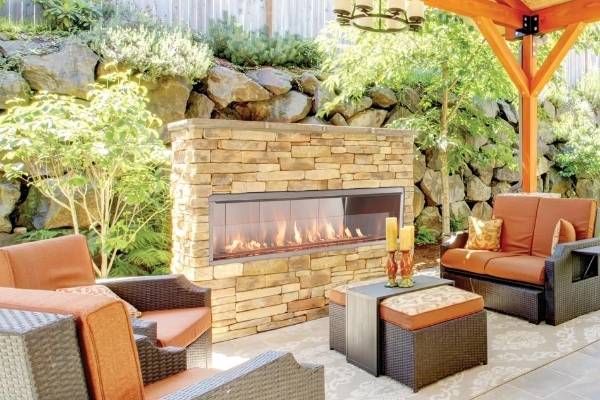
Photo: Superior Linear Vent-Free Outdoor Gas Fireplace, Optional See-Through, Sizes: 36"-72" Long

Photo: Majestic Courtyard Vent-Free Outdoor Natural Gas Fireplace, Sizes: 36" and 42
4. Ventless Gas Fireplace Inserts
These inserts are designed to be installed inside existing fireplace openings. With their help you can convert a traditional wood fireplace into a cleaner gas fireplace.
Click here to see our collection of Ventless Gas Fireplace Inserts
There are two types of ventless gas inserts you can explore:
Log inserts imitate a traditional fireplace look and usually look like a grate with a stack of logs and flames coming from the middle of them.
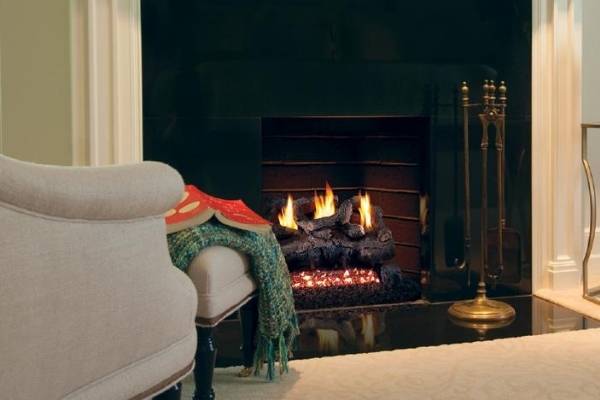
Photo: Real Fyre Ventless Gas Log Insert
Contemporary inserts take a more modern design approach. They usually look like the flame is coming from the sparkling pile of glass rocks.

Photo: Real Fyre Contemporary Gas Fireplace Insert
Are Ventless Gas Fireplaces Safe?
All ventless gas fireplaces are rigorously tested in laboratories to ensure they meet federal health and safety requirements before reaching the market.
Most ventless gas fireplaces come equipped with built-in ODS, short for oxygen detection sensors, and carbon monoxide (CO) detectors. The oxygen sensor can automatically shut off your fireplace should the oxygen levels in your room dip to a dangerously low level. The CO detector will also shut off the fireplace if it picks up carbon monoxide.
Pro Tip: While ventless gas fireplace safety requirements are highly regulated by government agencies and come with built-in monitors, installing a third-party carbon monoxide detector in your home is recommended.

Photo: Empire Boulevard 72" Linear Vent-Free Gas Fireplace
Ventless Gas Fireplace Safety Tips
1. Keep Combustible Materials Away From The fireplace
Do not allow Combustible Materials adjacent to or in contact with the fireplace. Combustible materials include wood, compressed paper, plant fibers, or other materials that will burn. These materials are considered combustible even when treated with fire-retardant chemicals.
2. Alert children and adults of hot surfaces.
Warn children and adults to stay away from the fireplace to avoid burns and clothing ignition
3. Supervise children.
Keep an eye on your children when they are in the same room as the fireplace.
4. Do not place flammables on the fireplace.
Do not place clothing or other flammable material on or near the fireplace.
5. Install a Carbon Monoxide Detector
While ventless gas fireplace safety requirements are highly regulated by government agencies and come with built-in monitors, installing a third-party carbon monoxide detector in your home is recommended.
Ventless Gas Fireplaces vs. Other Types of Fireplaces
As temperatures begin to dip and leaves start to fall, few things create a warm and inviting atmosphere faster than gathering around a fireplace. Fireplace lovers have more options than ever before, so we've put together a brief guide to walk you through the different types of fireplaces available.
Wood-Burning Fireplaces
Traditional wood-burning fireplaces have been around for hundreds of years. They usually consist of a brick or metal firebox and a chimney, though specific models use a vent in place of the conventional design. Unlike ventless gas fireplaces, they do produce smoke, smell, and emit dangerous particles into the air.
Pros:
- Fires are long-lasting if they are fueled properly
- It's easy to find wood chips and logs
- The scent of a traditional fire is comforting
- They are commonly found in many older homes
Cons:
- Most of the heat created by the fire will be lost, so they are not energy-efficient
- They require regular maintenance to remain safe and functional
- The smoke and emissions produced can be harmful
- Some homeowners associations have banned the use of wood-burning fireplaces
Electric Fireplaces
While they don't produce a real flame, electric fireplaces add warmth and ambiance to your home. Some even come equipped with the option to change the color of the electric flames depending on your mood or seasonal changes. However, many ventless gas fireplaces have an advantage over electric fireplaces because they work during power outages.
Pros:
- More affordable to buy and install
- No cleanup or maintenance required
- Some models can be moved from room to room
- No smell or air pollution because hey don't burn any form of fuel
- Great for zone heating and capable of heating small rooms
- Flames work without heat for year-round use
- Safe for pets and small children because they stay cool to the touch and there is no real flame
Cons:
- They can cause an increase in your electricity bill
- They won't provide heat or light during a power outage
Click here to learn more about electric fireplaces.

Photo: Dimplex IgniteXL Electric Fireplace
Vented Gas Fireplaces
Like ventless gas fireplaces, vented fireplaces require a gas line connecting to natural gas or a propane reservoir. Because they need a vent, they are better suited to homes with pre-existing chimneys and vents, as the cost of installing one is high.
Pros:
- The cost of fuel is relatively inexpensive compared to solid fuels like wooden logs
- They can warm your entire home depending on its size
- Many different designs are available, so you'll find something to suit your style
- There are remote controlled and continuous flame options available
Cons:
- As with wood-burning fireplaces, they lose heat through the vent and aren't energy-efficient
- Chimneys and vents need regular inspections to remain operational
- Unless your home has a pre-existing venting system, one will have to be installed
- More expensive installation, not possible in hi-rises, some condos or brick homes
Alcohol (Ethanol & Gel) Fireplaces
One of the cleanest burning fuels available, alcohol produces a substance similar to human breath, as it consists primarily of water vapor and carbon dioxide. Like ventless gas fireplaces, alcohol fireplaces don't require a vent or chimney.
Unlike with ventless gas fireplaces, there are no gas lines, which means alcohol fireplaces can be installed literally anywhere. However they do require additional fuel to operate. Alcohol fireplace fuel comes in gel or liquid form, and it is made of Isopropyl alcohol and Ethanol alcohol.
Pros:
- Alcohol is a clean-burning fuel, so they are eco-friendly
- They do not require a vent or chimney
- Since they don't require vents or gas lines, they are portable
- They don't produce any waste like ash or creosote
Cons:
- Alcohol based fuel is more expensive than natural gas
- You will need to use more alcohol to heat your space because it doesn't get as hot as gas
- Alcohol gels and liquids are not as readily available as other fuels
Click here to learn more about ethanol fireplaces.

Photo: EcoSmart Fire XL Series Stainless Steel Ethanol Fireplace Burner
Water Vapor Fireplaces
Like ventless gas fireplaces, water vapor (also called steam) fireplaces don’t require a vent or chimney. They operate using simple tap water and electricity to release a fine mist into the air. Perfect for homes with pets and small children, the realistic flames produced by a water vapor fireplace are cold to the touch.
Pros:
- They can be installed anywhere because they don’t require a vent
- They produce the most realistic imitation flames
- Because the flames are cool to the touch, they are safe for pets, children, and commercial spaces
- Water vapor fireplaces don’t produce harmful emissions
Cons:
- Because they run on electricity, they can’t operate during power outages
- They slightly increase air humidity which can be a concern in already humid climates
Click here to learn more about Water Vapor Fireplaces.

Photo: Dimplex Opti-myst® Pro 1500 - 65” One or Two Sided Vapor Fireplace with Heater (GBF1500-PRO)
Pros and Cons of Ventless Gas Fireplaces
A 20,000 BTU fireplace can heat up to 1,200 square feet, and because most don't require an electric pilot light, they're a fantastic addition to your home during power outages.
However, there are a few potential downsides to consider before installing a ventless gas fireplace in your home. We'll review the pros and cons below.
Pros:
- Because no heat escapes through a chimney, they have up to a 99% efficiency rating
- Ventless gas fireplaces can be installed in basements, newer homes and condos where chimney or venting is not an option
- Aside from an optional annual checkup, which shouldn't cost more than $150, they require very little maintenance
- They can be installed both indoors and outdoors
- Ventless gas fireplaces don't produce any waste like ash or creosote
- Modern models come equipped with built-in oxygen and carbon monoxide sensors
Cons:
- Some people are sensitive to gas fumes
- Some states and municipalities have banned the use of ventless gas fireplaces
- If your ventless fireplace uses propane, refills can be quite costly
- Because gas burns hot, they may not be suited for small spaces
Click here to shop ventless gas fireplaces.

Photo: Superior 43" Linear Vent-Free Gas Fireplace, Optional See-Through (VRL4543)
Can Ventless Gas Fireplaces Be Installed Outdoors?
Yes, ventless gas fireplaces can be installed outdoors! We offer several sturdy, weather-proof units that were crafted specifically for outdoor installation.
Having an outdoor fireplace adds to your space's ambiance and brings a touch of indoor comfort outside. They are also much more affordable and easier to install than traditional, wood-burning outdoor fireplaces, which many homeowners associations have banned due to environmental concerns.

Photo: Majestic Courtyard Vent-Free Outdoor Natural Gas Fireplace, Sizes: 36" and 42"
How to Choose the Right Ventless Gas Fireplace
Before you install a ventless gas fireplace in your home, you should ask yourself a few questions.
- Where are you planning to install your new fireplace? In the living room? Outdoors? In your bedroom? Some states, such as North Carolina, strictly prohibit ventless gas fireplaces from being installed in smaller spaces such as bedrooms and bathrooms, so you'll need to review the laws in your area before deciding on a location.
- Do you want to be able to heat your entire home in the event of a power outage? Make sure that ignition comes with a battery ack up and look for recommended BTU guidelines per square feet to find out what you'll need to heat your home.
- Are you installing your fireplace in a brand new construction, or are you renovating a prefab home? These factors can help you decide on the placement.
- Do you have enough space outdoors for a fireplace? If so, there are several attractive options. If not, don't give up yet. Some ventless gas fireplaces can be installed in a shared wall, half indoors and half outdoors.
- What is the style of your home? Are you looking for something modern and visually lightweight? Or do you prefer more traditional designs with added visual weight from details like a mantel? Taking your overall style into account creates a more cohesive, aesthetically pleasing home.
- How large is your space? Depending on the size of your rooms and your personal decorating style, a massive fireplace might not be your best option. Similarly, a slim, low-profile fireplace might not fit as well on a large wall.
- Last, but certainly not least, what is your budget? Vented gas fireplaces are an affordable option, but some have higher price points than others. You can stick to your budget and still have the fireplace of your dreams.
Thanks to their cost and energy efficiency, ventless gas fireplaces are an attractive addition to your home. Unlike traditional wood-burning fireplaces, which are inefficient for heating your home and produce waste and smoke, ventless gas fireplaces are a cleaner alternative for a much lower price.

Photo: Majestic Lanai 51" Vent-Free Outdoor Natural Gas Fireplace (ODLANAIG-51)
Most modern units feature carbon monoxide and oxygen detectors that will switch off your fireplace if oxygen levels drop too low or carbon levels exceed the naturally occurring trace amounts in a room. Because they are required to meet federal guidelines before they can be sold, you can trust that ventless gas fireplaces are safe when they are used correctly.
We hope now you feel more confident in choosing the best ventless gas fireplace for your home. If you have any questions, you can reach us at support@modernblaze.com, or you can click here to shop our ventless gas fireplaces.
Related Articles:
Shop Ventless Gas Fireplaces:
- Ventless Gas Fireplaces
- 2-Sided Ventless Gas Fireplaces
- Ventless Gas Fireplace Inserts
- Outdoor Gas Fireplaces
We share even more on Social Media:
Click Here to join our Design Community!
Check out our social media:
Pin this article:


